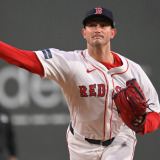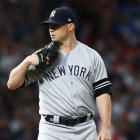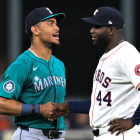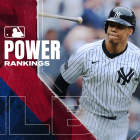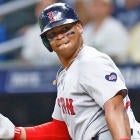HOUSTON -- Saturday night, the heavyweight fight that is the 2019 ALCS will begin at Minute Maid Park. The Houston Astros (107-55) will host the New York Yankees (103-59) in only the third ever postseason series featuring two 103-plus win teams, joining the 1912 World Series (Red Sox vs. Giants) and 2018 ALCS (Astros vs. Red Sox). Here's how you watch watch Game 1.
The Yankees outscored the Twins 23-7 in the three-game ALDS sweep and smothered Minnesota's high-powered offense with their bullpen. New York's relief crew allowed three runs with 16 strikeouts in 13 1/3 innings in the three-game series. The Twins bullpen was tagged for 14 runs in 12 innings. The Yankees are built around bullpen dominance.
"I think it's clear the bullpens will have to get important outs. You would expect some close games," Yankees manager Aaron Boone said Friday. "So games that come down to the end where if you're going to be able to win a ballgame you're going to have to close it out. So obviously we lean on our bullpen heavily."
Boone likes to say the Yankees have "lanes" for their high-leverage relievers, meaning they want to use them in specific situations. The Yankees have several different looks and styles in the bullpen and they try to maximize matchups whenever possible. With that in mind, let's look at the Astros' Game 1 lineup, and try to figure out everyone's "lane." Here is Houston's starting nine:
- CF George Springer
- LF Michael Brantley
- 2B Jose Altuve
- 3B Alex Bregman
- DH Yordan Alvarez
- 1B Yuli Gurriel
- SS Carlos Correa
- RF Kyle Tucker
- C Robinson Chirinos
The Green lane
Right-hander Chad Green pitched so poorly earlier this year that he found himself in Triple-A. Fourteen runs and a .395/.465/.763 batting line against in 7 2/3 innings will do that. Green went to Triple-A in April, made some mechanical adjustments, and returned in May. Since then he's pitched to a 2.64 ERA with 91 strikeouts and a .223/.282/.371 batting line against in 61 1/3 innings. That's the Chad Green the Yankees saw from 2017-18.
"If you look at his career, it's been spectacular to this point," Adam Ottavino said during the ALDS. "... Mentally, he's one of the best at his age. He doesn't get rattled by anything. He just goes out there and executes one pitch at a time. He's a really hard worker. He's really well prepared, really great teammate. He's kind of an ideal teammate. So for me, it's a joy to watch him pitch, and I think he's a huge key to our team."
There is little mystery when Green is on the mound. He throws his four-seamer fastball -- an upper-90s offering with a high spin rate -- nearly 80 percent of the time. His slider and splitter are show-me pitches. Green has an overpowering fastball and he throws it a lot, yet hitters still can't square it up. That skill set is uniquely suited for one portion of the Astros lineup: the 9-1-2 hitters.
Here are some regular season numbers against 96-plus mph four-seam fastballs (Green's averaged 96.4 mph in 2019):
| AVG | SLG | xwOBA | Swing & Miss Rate | |
|---|---|---|---|---|
No. 9 hitter Robinson Chirinos | .069 | .103 | .224 | 60.0% |
No. 1 hitter George Springer | .250 | .450 | .328 | 33.3% |
No. 2 hitter Michael Brantley | .258 | .355 | .298 | 9.8% |
MLB Average | .240 | .404 | .307 | 26.6% |
Expected weighted on-base average, or xwOBA, is scaled to on-base percentage and gives you an idea of what a hitter would have been expected to do given his exit velocity, launch angle, and other things like that. Long story short, the harder you hit the ball, the more damage you're expected to go. Exit velocity has been around forever. Now we can quantify it.
Chirinos was dreadful against high velocity during the regular season. One of the absolute worst hitters in the game against 96 mph or higher. Springer was better than league average, but not so much so that avoiding a fastball pitcher against him is a significant concern. Brantley didn't swing and miss much against big velocity at all. He just didn't drive the ball. No power at all.
Green and his high-velocity, high-spin fastball matches up well against the wraparound 9-1-2 portion of the Astros lineup. Those are three consecutive hitters who are susceptible to fastballs like Green's -- Springer isn't susceptible, necessarily, but he wasn't overly productive against those heaters during the season -- and the perfect lane to use him in Game 1.
The Ottavino lane
In addition to being one of the most GIF-able pitchers in baseball ...
Adam Ottavino, 93mph Two Seamer and 81mph Slider, Overay (w/ Tails). #GoodLuck pic.twitter.com/cEsIyH1rGn
— Rob Friedman (@PitchingNinja) August 26, 2019
... Ottavino is death on right-handed batters. That slider is the great equalizer, but he also features a running two-seamer that he'll throw away to righties for the comeback called strike. Everything he throws is away to righties (or is supposed to be away) and the hitter has to figure out whether it's a slider that will dart away from him or a two-seamer that will come back to catch the corner.
During the regular season Ottavino held righties to a .177/.292/.266 batting line with a 36.0 percent strikeout rate. He does have a hard time against lefties though -- lefties hit .241/.361/.392 with nearly as many walks (15) as strikeouts (21) against Ottavino during the regular season -- and the Yankees do try to keep him away from them. That's why he twice faced Nelson Cruz and only Nelson Cruz in the ALDS, and wasn't left in to face the lefty hitting Eddie Rosario as the next batter.
The Astros have righties hitting back-to-back in three spots in their lineup: Altuve and Bregman, Gurriel and Correa, and Chirinos and Springer. The Yankees typically use Ottavino against the other team's best righty hitters. That's why he faced Cruz in the ALDS and saw lots of Tommy Pham, Mookie Betts, Xander Bogaerts, and J.D. Martinez during the regular season. That leaves Altuve and Bregman as the most likely Ottavino lane. Consider:
- With all due respect, it isn't worth deploying a top reliever against Chirinos, the No. 9 hitter.
- Correa is currently in a 8 for 53 (.151) rut with 17 strikeouts that dates back to mid September.
- Bregman is Houston's best player and Altuve is no worse than their third best righty hitter.
Altuve and Bregman are back-to-back in the lineup and are inviting a top right-on-right matchup guy. It might not work, those two are really good, but that's the spot to use your go-to righty bullpen option. The Yankees gave Ottavino a three-year, $27 million contract this past offseason to do exactly this, to get guys like Altuve and Bregman out in October. They're his lane.
The Kahnle lane
In a bullpen with several bigger names, Tommy Kahnle can easily get lost in the shuffle. The changeup specialist had a 3.67 ERA during the regular season, which is nothing special, but he also had a 35.5 percent strikeout rate and an 8.1 percent walk rate. His 27.4 K-BB% was highest in the bullpen and 16th best in baseball. Also, Kahnle shuts down lefties despite being a righty:
| Opp. AVG/OBP/SLG | K% | BB% | GB% | |
|---|---|---|---|---|
vs. RHB | .209/.278./.400 | 32.8% | 8.2% | 54.9% |
vs. LHB | .191/.262/.327 | 38.1% | 7.9% | 45.5% |
Kahnle has a devastating power changeup -- the pitch averaged 90.0 mph during the regular season -- that he'll throw two, three, sometimes even four times in a row. Heck, he'll throw it on the first pitch of an at-bat, before he even throws his mid-to-upper-90s fastball to set it up. That changeup makes Kahnle very effective against lefties and gives Boone lots of options.
Looking at Houston's lineup, there seems like a nice lane for Kahnle in the 5-6-7-8 hitters. That's Alvarez (lefty), Gurriel (righty), Correa (righty), and Tucker (lefty). Kahnle is plenty good enough to face two righties like Gurriel and Correa -- that further frees up Ottavino as the Altuve/Bregman specialist -- and he can also handle Alvarez and Tucker. That's a four-batter lane.
The Astros spread the lefties in their lineup out in such a way that deploying a traditional left-on-left matchup guy won't be easy. It's pretty much one and done for a reliever like that. Kahnle is effectively a right-on-left specialist, however, with the adding bonus of being really good against righties. He gives the Yankees an awful lot of flexibility with his bullpen. They can use Kahnle at any time.
The Alvarez lane
This lane isn't so much about the pitchers. It's more about Alvarez, the Astros hotshot power-hitting rookie. Alvarez slugged 50 home runs -- 50! -- in 143 games between Triple-A and MLB this season, and managed to squeeze a full season's worth of production (27 HR and 78 RBI) into 87 big league games. He's been incredible.
Alvarez has been so good that he's worth a lane all to himself. The problem? The young left-handed hitter crushed lefty pitchers this season. He hit .307/.389/.649 against southpaws and actually had a lower strikeout rate against lefties (22.9 percent) than righties (26.9 percent). That said, it's a relatively small sample (131 plate appearances), and Alvarez was more productive against lefty fastballs than lefty breaking balls:
| AVG | SLG | xwOBA | Swing & Miss Rate | |
|---|---|---|---|---|
Alvarez vs. LHP fastballs | .333 | .684 | .472 | 13.9% |
MLB average (LHB vs. LHP fastballs) | .287 | .464 | .308 | 28.2% |
| AVG | SLG | xwOBA | Swing & Miss Rate | |
Average vs. LHP breaking balls | .280 | .640 | .310 | 36.1% |
MLB average (LHB vs. LHP fastballs) | .216 | .360 | .254 | 35.9% |
Compared to the league average, Alvarez was wildly successful against left-handed breaking balls during the regular season. He also wasn't as productive as he was against lefty fastballs, and the Statcast data suggests Alvarez may have been a little fortunate against lefties. He had .310 expected wOBA and a .389 actual wOBA against lefty breaking balls. There's a disconnect there.
Point is, the lane against Alvarez is a lefty with a really good breaking ball, and the Yankees have two in their ALCS bullpen: Tyler Lyons and CC Sabathia. Sabathia, who is on the ALCS roster after missing the ALDS with a shoulder injury, still has the nasty slider that helped him carve out a borderline Hall of Fame career. He held lefties to .198 batting average with a 25.5 percent strikeout rate during the regular season.
As for Lyons, he turned a September call-up into a postseason roster spot thanks to a high-spin breaking ball that sometimes looks like a slider and sometimes looks like a curveball. He's a veteran -- Lyons spent several years in the bullpen with the Cardinals -- who is a strict left-on-left guy, and Lyons could very well be on the ALCS roster to spin breaking balls away from Alvarez and nothing else. That's the lane here though. Against Alvarez, use a lefty with a wipeout breaking ball.
The Britton & Chapman lane
The final lane is the easiest one, because the Yankees use setup man Zack Britton and closer Aroldis Chapman in the eighth and ninth innings no matter the matchups. Those are their assigned innings. The Yankees showed a willingness to extend them in the ALDS -- Britton was going to throw two innings in Game 1 before the offense broke it open late, and Britton and Chapman covered the final nine outs in Game 5 -- and I'm sure the same will be true in the ALCS.
"They've communicated with us pretty well throughout the whole season how they may envision using us and stuff like that," Britton said during the ALDS. "So nothing's really changed going into the postseason. Obviously, we know we might be used a little earlier than normal, but they've been good at communicating that."
During the regular season the Yankees gave the ball to Britton when they had a lead in the eighth and Chapman when they had a lead in the ninth, and that was that. They closed the door. In the postseason, Britton could be involved in the seventh and Chapman could see action in the eighth, but, generally speaking, their lanes are the final 6-9 outs regardless of matches. They're among the top relievers in baseball and the Yankees will use them against any part of the lineup.
Of course, rarely do things go according to plan in baseball, so the Yankees will undoubtedly have to use their top high-leverage relievers outside their optimal lane in the ALCS. That's baseball, and they'll adjust when those situations arise. For now, it appears there is a landing spot in the Astros' Game 1 lineup for each of New York's primary bullpen arms.
"I see the Yankees carry 13 pitchers (on their ALCS roster). That will tell you right there that they're willing to mix and match and use their pitching creatively, at least have the resources there to do a lot," Astros manager A.J. Hinch said Saturday. "... The challenge is once you start that you kind of can't stop. You can't just go to the bullpen. You run out of pitching eventually. You have to have the right matchup and you have to have a lot of guys that have good days in order to do that."













